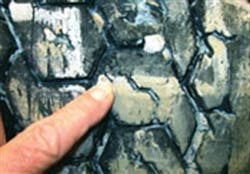What to look for when inspecting tires: Red flags include foreign objects, zipper bulges, cracking and cuts
In April, Ed Wagner examined the basics of visual truck tire examination. In this final installment of a two-part series, he looks at some of the conditions that a tire inspector may encounter during the retreading process.
The tire inspector’s job is to determine whether a used tire is retreadable. Sometimes tires sent in for retreading will be marked for specific wheel applications, such as “steer axle,” “trailer use only,” or “drive wheel position.”
Tread designs to be applied also may be marked. So while the inspector must decide a casing’s retreadability, he also must be aware of any special tread designs to be applied.
Note age
The inspector typically begins his examination in the tread area. He will usually mark the tread with crayon or chalk to indicate the starting point.
Inspectors usually locate the original DOT marking to note the age of the tire. There are some casings that do not have a DOT code. These are usually imported casings.
Retreaders cannot use any casing for retreading on which the DOT symbol or identification number has been removed by grooving or branding. This indicates that the tire is no longer suitable for any use.
Some trucking firms have specific casing age requirements like “not over seven years old,” for example. The retread shop itself might have a self-imposed age limit for casings.
At this time, I know of no regulation or guideline indicating a maximum casing age for truck tire retreading.
[PAGEBREAK]
Ready tread?
A typical truck tire will have a circumference of 120 inches or about 10 feet and a tread width of seven to eight inches.
This is the area that an inspector must examine for foreign objects such as imbedded stones, glass, nails, pieces of metal, etc. These objects must be removed with an awl. Then the casing must be probed to see if any damage has occurred to the underlying steel belts or cord fabric.
Nail/screw penetrations must be circled and noted for repair at the repair station.
While the sidewall and shoulder areas are exposed to operating damage, it’s the tread area that absorbs road contact -- and everything else on the road -- during its operation. Primary attention must be given to tread area examination.
[PAGEBREAK]
On the side
Sidewalls reflect potential internal damage to the tire’s body structure through lack of consistent air pressure or overload conditions.
The first tell-tale sign of a zipper rupture can be found on radial tire sidewalls by “feel” or by indirect lighting, which reveal vertical bulges. These bulges should be circled. All sidewall surface cuts should be circled for repair, too. Cuts that extend to the steel body ply will need special handling and possibly a section repair.
Sidewall rubber also is under constant attack by ozone and other atmospheric conditions.
Getting the bead
One of the most prevalent conditions in the bead area is commonly referred to as “circumferential cracking.” This is brought on by overloading, age and sometimes poor manufacturing in the ply turn-up area.
Another prevalent condition is chamfering of the inside bead area due to overload conditions.
A third common bead problem is the cutting or tearing of the bead’s bundle covering.
Cuts and tears down to the bead area are non-repairable; the casing should be rejected. However, simple rubber tears are repairable.
[PAGEBREAK]
Important job
Tire inspection is the primary step in the retread process. It combines individual training, workplace environment, adequate tools and equipment, plus professional supervision to ensure that all fundamentals are being pursued.
The individual tire inspector has a great responsibility in the examination and acceptance (or rejection) of truck tire casings for retreading.
Warning signs: The following conditions take tires out of circulation
Here are some of the conditions and injuries that disqualify tires from being retreaded:*
External: ply separation beyond repairable limits; tread separations that cannot be removed during buffing; broken, damaged, kinked or exposed bead wire; excessive oxidation extending to the body plies; circumferential cracking; any signs of weakness or non-repairable injury in the sidewall like ripples, bulges, etc.; crunching or popping sounds when flexed; surface cuts that exceed the size of a repairable injury and penetrate the cord body.
Internal: injuries to body plies in the non-repairable bead area; loose cords on the inside ply; evidence of running under-inflated or overloaded; open inner liner splices that expose cords; flex breaks or impact breaks; porous or loose inner liners; previous repairs that are defective or unrepairable.
The above conditions are reviewed periodically by a combination of industry groups, including the Tire Industry Association, the Rubber Manufacturers Association and the Tire Repair Material Manufacturers Group.
* Source: Industry Recommended Practices For Tire Retreading and Tire Repairing, Tire Retread Information Bureau.
Ed Wagner, formerly Modern Tire Dealer’s retread/repair editor, owns Louisville, Ky.-based Tire Technical Services Inc.
